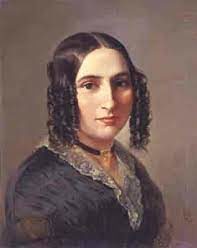“Musical prodigies … are probably no longer so rare; but what this little man can do in extemporizing and playing at sight borders the miraculous, and I could not have believed it possible at so early an age.” “And yet you heard Mozart in his seventh year at Frankfurt?” said Zelter. “Yes”, answered Goethe, “… but what your pupil already accomplishes, bears the same relation to the Mozart of that time that the cultivated talk of a grown-up person bears to the prattle of a child.”
– German Writer Johann Wolfgang von Goethe and Singakademie Director and Mendelssohn Music Teacher Carl Friedrich Zelter
THE MENDELSSOHNS IN 19TH CENTURY SOCIETY
Felix was born into an affluent and well-connected German Jewish family who regularly welcomed artists and intellectuals in their salon in Berlin. Even though the Mendelssohn parents had baptized the family as Christians when Felix was young, rising antisemitism in the late 19th and early 20th centuries impacted the public opinion of his work. Over time he has regained his merited status as a key figure in Romantic Era music history.


The Mendelssohn children had access to an education that allowed not only Felix to excel musically, but also his older sister Fanny (Hansel). Fanny composed over 450 pieces but her father did not support her pursuing music professionally, believing that it would reflect badly on their upper-middle-class family. Felix however deeply valued her critique and name championed her work, publishing some of her pieces under his name and later assembling her works to submit to his publisher.
While she did not pursue music the way Felix did, Fanny hosted salons where she would perform her own short piano compositions written specifically for domestic entertainment, contributing vastly to this modern genre of piano music.
Listen to Fanny Mendelssohn’s Notturno in G Minor
A TRUE RENAISSANCE MAN
Mendelssohn can be considered a true renaissance man thanks to his diverse intellectual pursuits. A child prodigy, he mastered piano, sightreading, violin and viola in his youth. He even had his first Singspiel (similar to an opera) performed by a professional orchestra and singers on his 12th birthday. One of Mendelssohn’s most notable non-musical pursuits was watercolour paintings and creating detailed sketches.
Like his Romantic Era contemporaries, Felix was moved and inspired by nature, developing a fascination with the landscapes of Scotland, namely the Hebrides, which he routinely sketched during his travels.
Here are some of Mendelssohn’s watercolour works.
THE BACH CONNECTION
Felix is known for his part in making Johann Sebastian Bach’s music more accessible to new audiences after it had declined in popularity over the years. His love of Bach’s music grew with influence from his family, beginning with his Great Aunt, a student and patron of Bach’s sons. She promoted the use of Bach’s music at the Berlin Singakademie. The Singakademie Director, Carl Friedrich Zelter, eventually became Felix and Fanny’s music tutor, continuing to nurture their Bach education and appreciation.
Felix’s Grandmother also gifted Felix with a copyist’s manuscript of Bach’s St. Matthew Passion score when he was 16 years old. At 20, he arranged a performance of the work that brought Bach in front of new audiences and garnered immense success. Later in his career, Mendelssohn lived near the church Bach worked at in Leipzig, St. Thomas, and had a statue mounted in Bach’s honour that is still standing today.
INHERITANCE AND LEGACY
Mendelssohn was part of the early Romantic period, a time of transition when some composers were writing in more of the classical style and some were pushing ahead with a new style. Mendelssohn wrote in a combination of Classical and Romantic styles, using elements and inspiration from both. For example, he embraced the Romantic trend of his day of compositions inspired by nature and programmatic music based on literature, such as his celebrated work A Midsummer Night’s Dream.
He was an influential pillar of the European musical scene and could decide which music to conduct and promote, cementing the place of many Baroque and Classical composers by programming their works and presenting them to the public. A tremendous supporter of composers of his time, he commissioned and conducted many works at the famous Gewandhaus Orchestra in Leipzig where he was Music Director.
Mendelssohn was also a legendary conductor and was one of the first to use a baton. His meticulous work and high expectations for his orchestra players created legendary and brilliant performances. He even founded the Leipzig Conservatory of Music, Germany’s first university-level music school, which raised the bar on music education and highly trained generations of Europe’s fine musicians.
A ROYAL RELATIONSHIP
Mendelssohn developed a close friendship with both Queen Victoria and her husband King Albert. Victoria would even sing and play piano with Mendelssohn and famously requested to publicly perform a duet of one of his pieces with him. Following this performance, he made the shocking reveal that this favoured piece chosen by the Queen was in fact written by his sister, Fanny.
Queen Victoria started a trend still seen today when she selected Mendelssohn’s Wedding March from his Overture to A Midsummer Night’s Dream for her daughter Princess Victoria’s wedding.
Listen to the Berliner Philharmoniker’s 2013 performance of Mendelssohn’s Wedding March here.
Learn more about Felix Mendelssohn and the impact of the Romantic Era during the HPO 21-22 Composer Festival happening online February 22-27. See all events here.

